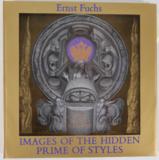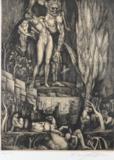Ernst Fuchs *

(Vienna 1930–2015)
“Christus vor Pilatus”, signed Ernst Fuchs (left corner) as well as signed, dated Ernst Fuchs 1956, pen, brush, ink on Ingres, on hardboard, 48 x 62.5 cm, framed
Exhibited:
Wiener Schule des Phantastischen Realismus - travel exhibition 1972, Tokyo, Odakyu - warehouse/Kobe, Museum of Modern Art, Hoyogo/Nagoya, Museum of Art, Aichi (label on the reverse)
Full-page colour illustration (over two pages):
Fuchs über Ernst Fuchs. Bilder und Zeichnungen von 1945–1976, Galerie Richard P. Hartmann (ed.), R. Piper & Co. Verlag, 1977, pp. 116–117
Ernst Fuchs. Zeichnungen und Graphik, Aus der frühen Schaffensperiode 1942–1950, Friedrich Haider (ed.), Löcker Verlag Vienna, 2003, pp. 253, 259 (over two pages), detail pp. 254, 255, 257
Provenance:
Eva-Christina Fuchs – gift from her husband, the artist
Charlotte Prosek, Vienna
Private Collection, Vienna
Collection Edita Gruberová (1946-2021)
thence by descent
Christus vor Pilatus (Christ before Pilate), the Mannerist composition created mostly in New York in 1955–56, is one of Fuchs's major works from the drawings of the 1950s. Originally conceived as small format (as can be seen from the join at Pilate's skirt), the sheet was subsequently expanded into a grandiose, symbolist production and now counts towards the pictorial documents that highlight the artist's path into the Catholic Church. However, the significance that Jesus of Nazareth had for him at this point can only really be understood by analysing the role of death in the works created up to that point.
DEATH
... In medieval or romantic dances, a redeeming God and the immortal soul found expression alongside death: “The partner, the soul, was finally taken from the bony dancer”. Fuchs, however, does not envisage such consolation in his works for a long time. “This bony figure did not increase, did not decrease, showed immutable features, was incapable of change.” Only in Christ before Pilate does a sign of transcendence appear for the first time: “A beyond shines forth, shows itself in the form of the dove, the Holy Spirit hovering above the figure of Christ”.
THE UNICORN
The unicorn is given heavy, almost monstrous features. The beer-carriage-pulling Pinzgauer from Vienna's post-war cityscape is recreated here. The unicorn is unconquerable and of invincible power; it is also unrecognisable, unknown, and therefore of divine radiance. It points its horn at death and thus identifies itself as its adversary. ...
THE GRAVE WORLD
The right part of the drawing is taken up by graves or “death blocks”. Under the cross lies a fallen sacrificial figure in an architectural perspective that was considered futuristic when the work was created. The interlacing of this figure with the leg of the unicorn is a figurative motif: “Precisely in the step is the tread”. In the first of the death blocks appears a portrait of Gustav Klimt, a painter of high sensuality who dealt with the antagonism of life and death in a symbolist painting of the same name, just as Fuchs does in this drawing.
PILATE AND CHRIST
In various works, Fuchs used the tiara as a sign of “majesty” - especially in connection with the crucified Christ. Various wings of Catholic Church accused him of blasphemy for this. Here, as a sign of high priestliness, Pilate himself wears the bishop's mitre, for in the act of condemning he is governor and Cephas in one. Although his hand position expresses an acknowledgement of Jesus' majesty, he too is under the compulsion not to acknowledge the Saviour. The Son of Man, standing before the abyss, must go as it is written.
THE WITNESSES
All are witnesses to the presence of Christ, through a guilty conscience or otherwise. The horrified and outraged, the Pharisees and unbelievers are in the majority, the believers in the minority; the artist has also placed himself in the group in the form of a small self-portrait. ...
from the literature cited above (2003)
Esperta: Mag. Elke Königseder
 Mag. Elke Königseder
Mag. Elke Königseder
+43-1-515 60-358
elke.koenigseder@dorotheum.at
29.11.2022 - 18:00
- Stima:
-
EUR 70.000,- a EUR 120.000,-
Ernst Fuchs *
(Vienna 1930–2015)
“Christus vor Pilatus”, signed Ernst Fuchs (left corner) as well as signed, dated Ernst Fuchs 1956, pen, brush, ink on Ingres, on hardboard, 48 x 62.5 cm, framed
Exhibited:
Wiener Schule des Phantastischen Realismus - travel exhibition 1972, Tokyo, Odakyu - warehouse/Kobe, Museum of Modern Art, Hoyogo/Nagoya, Museum of Art, Aichi (label on the reverse)
Full-page colour illustration (over two pages):
Fuchs über Ernst Fuchs. Bilder und Zeichnungen von 1945–1976, Galerie Richard P. Hartmann (ed.), R. Piper & Co. Verlag, 1977, pp. 116–117
Ernst Fuchs. Zeichnungen und Graphik, Aus der frühen Schaffensperiode 1942–1950, Friedrich Haider (ed.), Löcker Verlag Vienna, 2003, pp. 253, 259 (over two pages), detail pp. 254, 255, 257
Provenance:
Eva-Christina Fuchs – gift from her husband, the artist
Charlotte Prosek, Vienna
Private Collection, Vienna
Collection Edita Gruberová (1946-2021)
thence by descent
Christus vor Pilatus (Christ before Pilate), the Mannerist composition created mostly in New York in 1955–56, is one of Fuchs's major works from the drawings of the 1950s. Originally conceived as small format (as can be seen from the join at Pilate's skirt), the sheet was subsequently expanded into a grandiose, symbolist production and now counts towards the pictorial documents that highlight the artist's path into the Catholic Church. However, the significance that Jesus of Nazareth had for him at this point can only really be understood by analysing the role of death in the works created up to that point.
DEATH
... In medieval or romantic dances, a redeeming God and the immortal soul found expression alongside death: “The partner, the soul, was finally taken from the bony dancer”. Fuchs, however, does not envisage such consolation in his works for a long time. “This bony figure did not increase, did not decrease, showed immutable features, was incapable of change.” Only in Christ before Pilate does a sign of transcendence appear for the first time: “A beyond shines forth, shows itself in the form of the dove, the Holy Spirit hovering above the figure of Christ”.
THE UNICORN
The unicorn is given heavy, almost monstrous features. The beer-carriage-pulling Pinzgauer from Vienna's post-war cityscape is recreated here. The unicorn is unconquerable and of invincible power; it is also unrecognisable, unknown, and therefore of divine radiance. It points its horn at death and thus identifies itself as its adversary. ...
THE GRAVE WORLD
The right part of the drawing is taken up by graves or “death blocks”. Under the cross lies a fallen sacrificial figure in an architectural perspective that was considered futuristic when the work was created. The interlacing of this figure with the leg of the unicorn is a figurative motif: “Precisely in the step is the tread”. In the first of the death blocks appears a portrait of Gustav Klimt, a painter of high sensuality who dealt with the antagonism of life and death in a symbolist painting of the same name, just as Fuchs does in this drawing.
PILATE AND CHRIST
In various works, Fuchs used the tiara as a sign of “majesty” - especially in connection with the crucified Christ. Various wings of Catholic Church accused him of blasphemy for this. Here, as a sign of high priestliness, Pilate himself wears the bishop's mitre, for in the act of condemning he is governor and Cephas in one. Although his hand position expresses an acknowledgement of Jesus' majesty, he too is under the compulsion not to acknowledge the Saviour. The Son of Man, standing before the abyss, must go as it is written.
THE WITNESSES
All are witnesses to the presence of Christ, through a guilty conscience or otherwise. The horrified and outraged, the Pharisees and unbelievers are in the majority, the believers in the minority; the artist has also placed himself in the group in the form of a small self-portrait. ...
from the literature cited above (2003)
Esperta: Mag. Elke Königseder
 Mag. Elke Königseder
Mag. Elke Königseder
+43-1-515 60-358
elke.koenigseder@dorotheum.at
|
Hotline dell'acquirente
lun-ven: 10.00 - 17.00
kundendienst@dorotheum.at +43 1 515 60 200 |
| Asta: | Arte moderna |
| Tipo d'asta: | Asta in sala con Live Bidding |
| Data: | 29.11.2022 - 18:00 |
| Luogo dell'asta: | Wien | Palais Dorotheum |
| Esposizione: | 22.11. - 29.11.2022 |
Altri oggetti dell'artista
-

Prezzo di partenza:
EUR 320,- -

Prezzo di partenza:
EUR 280,- -

Prezzo di partenza:
EUR 140,-
